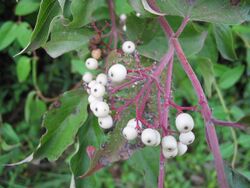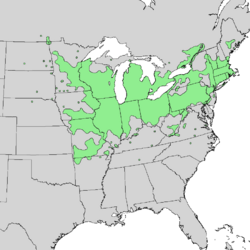Biology:Cornus racemosa
| Cornus racemosa | |
|---|---|

| |
| Berries | |
| Scientific classification | |
| Kingdom: | Plantae |
| Clade: | Tracheophytes |
| Clade: | Angiosperms |
| Clade: | Eudicots |
| Clade: | Asterids |
| Order: | Cornales |
| Family: | Cornaceae |
| Genus: | Cornus |
| Subgenus: | Cornus subg. Kraniopsis |
| Species: | C. racemosa
|
| Binomial name | |
| Cornus racemosa Lam.
| |

| |
| Natural range of Cornus racemosa | |
| Synonyms | |
| |
Cornus racemosa, the northern swamp dogwood, gray dogwood, or panicle dogwood, is a shrubby plant native to southeastern Canada and the northeastern United States. It is a member of the dogwood genus Cornus and the family Cornaceae.
Description
Gray dogwood grows 1.2 to 3 m (4 to 10 ft) high, rarely to 8 m (26 ft).[3] It often sends up suckers from underground rhizomes, forming thickets. Its bark is gray and its twigs have white pith. The leaves are 4–8 cm (1 1⁄2–3 1⁄4 in) long and 1–4 cm (1⁄2–1 1⁄2 in) wide, and typically have 3 or 4 pairs of lateral veins, fewer than other dogwood species.[4] The plant grows upright with a rounded habit, oppositely arranged leaves, and terminally born flowers. The white flowers are small, with four petals 2.3 to 3 mm (0.091 to 0.118 in) long, and clustered together in rounded clusters 2.5 to 5 cm (1 to 2 in) wide called diachasial cymes,[4] produced sometime between May and July.[5] After flowering, green fruits (drupes) are produced, and they ripen and turn white from August to October.[5] The flowers and fruit are attached to the plant by bright red pedicels. Many species of birds feed on the fruits.[4] Old branches grow slowly, while new stems are fast growing. In the fall the foliage can take on a reddish or purplish color, though it is not overly showy from a distance.
Classification
Cornus racemosa has been variably treated as a subspecies of Cornus foemina Mill., with which it overlaps.[5]
It occasionally hybridizes with Cornus amomum (silky dogwood), the products of which are named Cornus × arnoldiana.[6]
References
- ↑ "NatureServe Explorer 2.0". https://explorer.natureserve.org/Taxon/ELEMENT_GLOBAL.2.139198/Cornus_racemosa.
- ↑ "Cornus racemosa Lam. | Plants of the World Online | Kew Science". https://powo.science.kew.org/taxon/urn:lsid:ipni.org:names:271653-1.
- ↑ Coladonato, Milo (1993), Cornus racemosa, US Department of Agriculture (USDA), Forest Service (USFS), Rocky Mountain Research Station, Fire Sciences Laboratory, https://www.fs.fed.us/database/feis/plants/tree/corrac/all.html
- ↑ 4.0 4.1 4.2 "Swida racemosa (gray dogwood)", Go Botany (New England Wildflower Society), https://gobotany.nativeplanttrust.org/species/Swida/racemosa/, retrieved 8 November 2015
- ↑ 5.0 5.1 5.2 Murrell, Zack E.; Poindexter, Derick B. (2016), "Cornus racemosa", in Flora of North America Editorial Committee, Flora of North America North of Mexico (FNA), 12, New York and Oxford, http://www.efloras.org/florataxon.aspx?flora_id=1&taxon_id=10219
- ↑ "Cornus × arnoldiana". World Checklist of Selected Plant Families. Royal Botanic Gardens, Kew. http://wcsp.science.kew.org/namedetail.do?name_id=47284. Retrieved 2018-07-28.
External links
| Wikimedia Commons has media related to Cornus racemosa. |
- Cornus racemosa description with pictures
- "Cornus racemosa". Natural Resources Conservation Service PLANTS Database. USDA. https://plants.usda.gov/core/profile?symbol=CORA6.
- Brief description and pictures
Wikidata ☰ Q1134291 entry
 |


